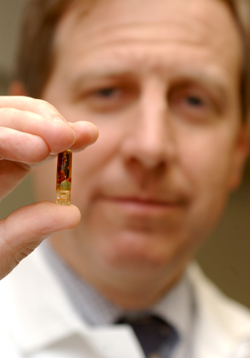
Dr. Christopher D. Lind, associate professor of Medicine in the division of Gastroenterology, holds the the new pH level monitoring device which is attached to a patient’s esophagus. Photo by Dana Johnson
by Jessica Howard
Starting next week, doctors in The Vanderbilt Clinic will begin using a new procedure to monitor the esophageal pH activities in patients suspected of suffering from gastroesophageal reflux disease (GERD). The procedure allows doctors to test pH levels without requiring patients to wear a trans-nasal catheter for 24 hours, as with the classic monitoring method.
The device, called the Bravo pH Monitoring System, is about the size of a pill. Designed by Medtronics, the pH monitor is attached to the wall of the esophagus through a temporary catheter, which is then removed. The patient wears a pager-sized receiver for the duration of the 24-to 48-hour test. Once the test is completed, the patient returns the receiver to TVC, where the information will be downloaded for analysis. The tiny monitoring device will naturally pass through the patient’s system in a few days.
The procedure takes about 10 minutes to attach the device, and is usually preceded by an esophageal motility study, which lasts 20 to 30 minutes.
Dr. Christopher D. Lind, associate professor of Medicine in the division of Gastroenterology, said the new procedure will improve quality of life for patients that might not be able to handle the prolonged discomfort of a catheter.
“I had one patient who came in twice unsuccessfully for the classic procedure,” Lind said. “After the catheter was inserted, he would eventually cough it back up and has not yet been able to tolerate it for the duration of the test.”
He estimates that one out of every six patients who come in for the classic procedure have not or were not willing to endure the discomfort.
“The easier we can make things on a patient, the more likely they can be compliant about seeking treatment,” Lind said.
Lind said that patients who need the pH study are either being evaluated for acid reflux surgery or they have exhibited atypical symptoms of GERD — for example, chronic cough, hoarseness or changes in vocal chords — that need to be confirmed as GERD.
Another potential benefit of the new procedure is that the monitoring device can remain in the system up to 48 hours, in which the prolonged monitoring might provide a more accurate measure of a patient’s day-to-day activities, according to Lind.













